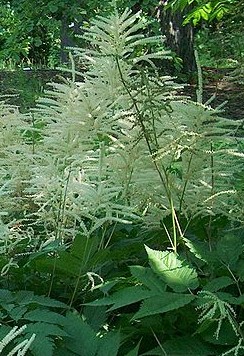 This shrub-like herbaceous perennial, also known as bride’s feather, is native to North America, and northern Europe and Asia where it grows in moist woodlands. It is a member of the rose family, Rosaceae, that also includes apples, Pyracantha, and meadowsweet. Plants grow 4-6′ tall and form clumps up to 4′ wide. The dark green leaves are two to three foot long and tri-pinnately compound. In early to mid-summer creamy white male and female flowers appear in open plumes on different plants and are one to two feet long. Male plumes are more upright, brighter white, and are feathery because of their numerous stamens. The flowers attract butterflies and the plant serves as a larval host for dusky azure. Goats beard is a good back of the border plant where it has plenty of room to develop into a large clump. For smaller gardens the three foot tall cultivar ‘Kneiffii’ may be more suitable. Goat’s beard grows well in a variety of soil and light conditions but needs some afternoon shade and plenty of water in the southern part of its range. The plants are especially attractive growing along a stream or in a bog or water garden. The genus name, Aruncus, comes from the Greek word aryngos meaning goat’s beard, perhapsreferring to the appearance of the flowerheadsThe specific epithet, dioicus, is from the Ancient Greek words δίς meaning twice and οἶκος meaning house, referring to the fact that male and female flowers appear on different plants.
This shrub-like herbaceous perennial, also known as bride’s feather, is native to North America, and northern Europe and Asia where it grows in moist woodlands. It is a member of the rose family, Rosaceae, that also includes apples, Pyracantha, and meadowsweet. Plants grow 4-6′ tall and form clumps up to 4′ wide. The dark green leaves are two to three foot long and tri-pinnately compound. In early to mid-summer creamy white male and female flowers appear in open plumes on different plants and are one to two feet long. Male plumes are more upright, brighter white, and are feathery because of their numerous stamens. The flowers attract butterflies and the plant serves as a larval host for dusky azure. Goats beard is a good back of the border plant where it has plenty of room to develop into a large clump. For smaller gardens the three foot tall cultivar ‘Kneiffii’ may be more suitable. Goat’s beard grows well in a variety of soil and light conditions but needs some afternoon shade and plenty of water in the southern part of its range. The plants are especially attractive growing along a stream or in a bog or water garden. The genus name, Aruncus, comes from the Greek word aryngos meaning goat’s beard, perhapsreferring to the appearance of the flowerheadsThe specific epithet, dioicus, is from the Ancient Greek words δίς meaning twice and οἶκος meaning house, referring to the fact that male and female flowers appear on different plants.
Type: Herbaceous perennial
Bloom: One to two foot long plumes of male or female flowers on different plants in early to mid-summer
Size: 4-6’ H x 4-6’ W
Light: Full sun to part shade; afternoon shade in southern part of range
Soil: Fertile, moderate moist to wet but tolerates less
Hardiness: Zones 3-7
Care: Low maintenance; deadhead,
Pests and Diseases: None of significance
Propagation: Seed, division in spring
Outstanding Selection: ‘Kneiffii’ ( dwarf at 3′ tall)
Companion plants: Ferns, hosta, Virginia bluebells, Jacob’s ladder, woodland phlox, bergenia, black cohosh, monkshood and common foxglove.
